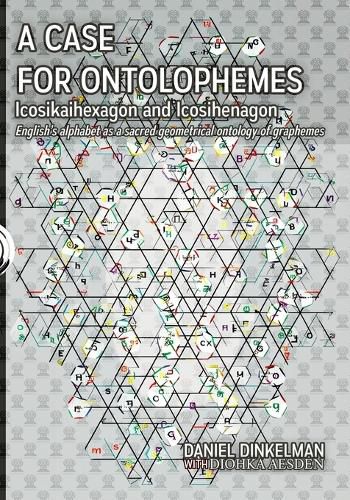Readings Newsletter
Become a Readings Member to make your shopping experience even easier.
Sign in or sign up for free!
You’re not far away from qualifying for FREE standard shipping within Australia
You’ve qualified for FREE standard shipping within Australia
The cart is loading…






A Case for Ontolophemes: Icosikaihexagon and Icosihenagon - English's alphabet as a sacred geometrical ontology of graphemes
Dinkelman, Daniel Aesden, Diohka
In this rigorously researched volume, the English alphabet's exoteric 26-letter form-its "icosikaihexagon"-is unveiled as the outward shell of a far older "icosihenagon" of conceptual foundations. Combining philological analysis, comparative script histories, and engaging scholarship, A Case for Ontolophemes contends that each English letter descends from archaic glyphs that once denoted fundamental objects: "ox," "house," "fish," "door," and other vital elements of Bronze Age Levantine life. Beneath everyday orthography, the author reveals a hidden atlas of ontic units, bridging mundane literacy and the archaic synergy of culture and environment.
Designed for an academic and professional readership, this work meticulously surveys Proto-Sinaitic, Phoenician, Greek, and Latin scripts, illustrating how single ancestral glyphs diversified-often duplicating to form today's expanded exoteric set. Readers will discover how "U, V, W, and Y" all trace back to a single hook or peg (Waw), how "I" and "J" emerge from a primal "hand" (Yod), and how "C" and "G" share the "camel" impetus (Gimel). The authors situate each letter in a broader cultural and ecological context, underscoring that alphabets emerged not in isolation but from agrarian and pastoral realities, cosmic mythmaking, and scribal rituals.
Beyond historical exposition, A Case for Ontolophemes proposes fresh educational and creative pathways. It maps out how teaching and conlang design might re-energize modern literacy by reclaiming these symbolic or ecological origins-rekindling a sense of wonder, aesthetic depth, and spiritual resonance in the act of reading and writing. Engaging "phonosemantic" arguments, it also surveys tools for forging new alphabets that echo archaic traditions yet speak to contemporary ecological and cultural concerns.
Complete with visual charts, genealogical diagrams, and comprehensive appendices on references and proposed symbolic genealogies, this scholarly monograph invites linguists, educators, cultural historians, conlangers, and script aficionados alike to explore the total interlacing of form, function, and fundamental ontology in the letters we use daily.
$9.00 standard shipping within Australia
FREE standard shipping within Australia for orders over $100.00
Express & International shipping calculated at checkout
A Case for Ontolophemes: Icosikaihexagon and Icosihenagon - English's alphabet as a sacred geometrical ontology of graphemes
Dinkelman, Daniel Aesden, Diohka
In this rigorously researched volume, the English alphabet's exoteric 26-letter form-its "icosikaihexagon"-is unveiled as the outward shell of a far older "icosihenagon" of conceptual foundations. Combining philological analysis, comparative script histories, and engaging scholarship, A Case for Ontolophemes contends that each English letter descends from archaic glyphs that once denoted fundamental objects: "ox," "house," "fish," "door," and other vital elements of Bronze Age Levantine life. Beneath everyday orthography, the author reveals a hidden atlas of ontic units, bridging mundane literacy and the archaic synergy of culture and environment.
Designed for an academic and professional readership, this work meticulously surveys Proto-Sinaitic, Phoenician, Greek, and Latin scripts, illustrating how single ancestral glyphs diversified-often duplicating to form today's expanded exoteric set. Readers will discover how "U, V, W, and Y" all trace back to a single hook or peg (Waw), how "I" and "J" emerge from a primal "hand" (Yod), and how "C" and "G" share the "camel" impetus (Gimel). The authors situate each letter in a broader cultural and ecological context, underscoring that alphabets emerged not in isolation but from agrarian and pastoral realities, cosmic mythmaking, and scribal rituals.
Beyond historical exposition, A Case for Ontolophemes proposes fresh educational and creative pathways. It maps out how teaching and conlang design might re-energize modern literacy by reclaiming these symbolic or ecological origins-rekindling a sense of wonder, aesthetic depth, and spiritual resonance in the act of reading and writing. Engaging "phonosemantic" arguments, it also surveys tools for forging new alphabets that echo archaic traditions yet speak to contemporary ecological and cultural concerns.
Complete with visual charts, genealogical diagrams, and comprehensive appendices on references and proposed symbolic genealogies, this scholarly monograph invites linguists, educators, cultural historians, conlangers, and script aficionados alike to explore the total interlacing of form, function, and fundamental ontology in the letters we use daily.